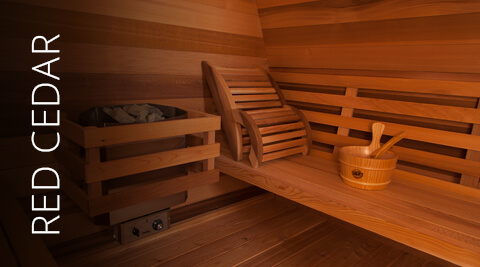The Buzz on Traditional Sauna
The Buzz on Traditional Sauna
Blog Article
The 25-Second Trick For Traditional Sauna
Table of ContentsTraditional Sauna Can Be Fun For AnyoneTraditional Sauna Things To Know Before You Get ThisThe Ultimate Guide To Traditional SaunaThings about Traditional SaunaThe Greatest Guide To Traditional Sauna
Energy savings is one thing to take into consideration for people that intend on using their sauna frequently. For a typical sauna, bathers typically require to wait for 30-40 mins for the space to preheat prior to getting in. Infrared saunas, on the other hand, typically reach their optimal temperature in around 15 minutes.That indicates that in an infrared sauna, bathers can start appreciating their sauna promptly. One difference between the 2 types of sauna that is usually neglected is the social experience.
Think about how lots of individuals will certainly be utilizing the sauna before making your choice - Traditional Sauna. Including a sauna to your home can be one of the most interesting and fulfilling decisions you'll ever before make. Regular sauna usage will boost your circulation, maintain healthier skin, assistance kidney feature, minimize high blood pressure, enhance mind feature, and a lot more
Fascination About Traditional Sauna

Infrared and typical dry saunas are both popular alternatives for those looking for relaxation and healing advantages. There are some key distinctions between the two kinds of saunas that need to be considered before making a selection. Typical completely dry saunas make use of warmed rocks to create steam, while infrared saunas utilize infrared heating units to straight heat the body.
Elements such as heat tolerance, desired degree of detoxification, and general wellness needs to be taken into consideration when deciding which type of sauna to use. Infrared saunas are a sort of sauna that utilize infrared light to warm the body directly, instead of warming the air around the body like standard saunas.
The temperature level in an infrared sauna is typically less than in a typical sauna, with temperature levels ranging from 120F to 150F. Traditional Sauna. Infrared saunas provide a variety of benefits that make them an eye-catching option for those aiming to improve their health and wellbeing. Some of the benefits of infrared saunas consist of: Infrared saunas use reduced temperatures than traditional saunas, which can make them extra comfy for those who locate heats difficult to endure
Indicators on Traditional Sauna You Should Know
This can aid to advertise relaxation, minimize muscle tension, and alleviate pain. Some specialists suggest that infrared saunas might offer benefits for soothing an aching throat. Infrared saunas have been revealed to assist the body get rid of toxic substances via sweating. you could look here Sweating can additionally aid to enhance skin health by getting rid of contaminations and dead skin cells.
The warm created by infrared saunas can aid to increase blood flow and enhance flow. Infrared saunas have actually been shown to aid decrease stress and anxiety and advertise leisure.

Not known Incorrect Statements About Traditional Sauna

There are several benefits to utilizing a standard dry sauna. Below are a few: Relaxation: The high temperature and low humidity in typical dry saunas can aid loosen up the muscles and minimize tension levels. Detoxification: Sweating in a sauna can assist eliminate contaminants from the body, which can improve total health.
When it comes to saunas, there are two main kinds of heating approaches: conventional and infrared. Traditional saunas utilize warmed air to warm up the body, while infrared saunas utilize infrared radiation to pass through the skin and heat the body from within. Among the primary differences between both approaches is the kind of heat they produce.
Conventional saunas heat the air, which then warms the body with convection. Infrared saunas, on the various other hand, warm the body directly via radiation.
In terms of energy efficiency, infrared saunas are normally more effective than conventional saunas due to the fact that they call for much less power to operate. They also heat up faster, so they can be used for shorter sessions. When it pertains to the impacts on the body, both types of check it out saunas have actually been revealed to have benefits.
7 Easy Facts About Traditional Sauna Explained
Infrared saunas have been shown to have comparable benefits, in addition to potentially assisting with cleansing, skin wellness, and immune feature. Overall, the option in between a typical or infrared sauna comes down to individual choice and private requirements. Conventional saunas may be better for those who prefer higher temperature levels and a more extreme sweat action, while infrared saunas may be better for those that desire an even more gentle and effective warm therapy.
Both kinds of saunas provide distinct benefits and downsides that ought to be thought about prior to making a choice. The selection in between an infrared sauna and a traditional completely dry sauna greatly depends on individual choice and the preferred benefits - Traditional Sauna. Those who like a more comfy, reduced temperature level atmosphere may prefer an infrared sauna, while those who are searching for intense warmth and a standard sauna experience might favor a traditional dry sauna
Here are some safety and security ideas to keep in mind when utilizing infrared and traditional dry saunas:: Saunas can trigger too much sweating, causing dehydration. It is vital to drink a lot of water before, during, and after sauna sessions to stay hydrated.: It is advised to restrict sauna sessions to 20-30 minutes to prevent overheating and dehydration.
Report this page